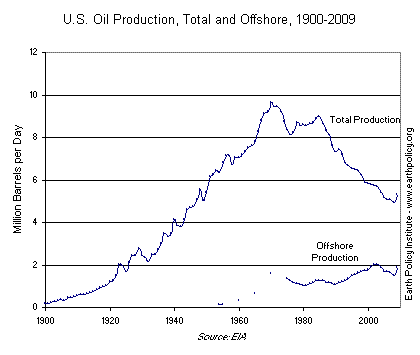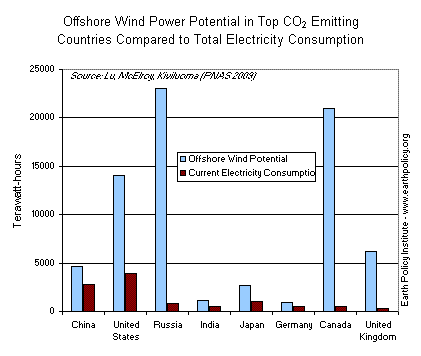This piece was written by my colleague Janet Larsen at the Earth Policy Institute.
The enormously devastating oil spill in the Gulf of Mexico is just one reminder that stretching out an addiction to a polluting and planet-warming fossil fuel poses risks to our health, our environment, and our economy.
U.S. oil production peaked in 1970 at 9.6 million barrels per day. Since then production has dropped by almost half and now supplies less than 30 percent of domestic consumption. In 2009, the United States spent nearly $200 billion on oil imports to make up the difference.

With oil wells on land getting tapped out, U.S. oil production would have fallen off even more precipitously than it did if not for offshore oil. Offshore oil production now comprises about a third of the U.S. total. Yet remaining resources are limited and are becoming increasingly difficult to obtain. As BP’s inability to staunch the Deepwater Horizon oil spill starkly illustrates, controlling extraction from almost a mile below the sea surface is incredibly difficult and dangerous.
The era of “easy” oil is over. As Fatih Birol, chief economist of the International Energy Agency, recommends for the world, “we should not cling to crude down to the last drop – we should leave oil before it leaves us.”
Fortunately there are alternatives. Much of the U.S. oil consumption of nearly 20 million barrels a day goes to run vehicles, the same vehicles that get city commuters stuck in traffic for a cumulative 4.2 billion hours a year, costing society some $87 billion, according to the Texas Transportation Institute. To cut dependence on oil, transportation options can be expanded beyond single-passenger vehicles to bus rapid transit, light rail, high speed rail, and space for bicycles and pedestrians.
Even though the U.S automobile fleet shrank by 4 million vehicles last year, cars will not disappear completely any time soon. However, the fleet can be cleaned up by marrying the electric and plug-in hybrid electric vehicles now starting to come to market to renewably-produced electricity. The U.S. Pacific Northwest National Laboratory estimates that the current electrical infrastructure could power over 80 percent of the U.S. car fleet, relying largely on off-peak electricity as cars are charged at night. Upgrading to a stronger, smarter, and interconnected national grid that taps into the country’s enormous wind, solar, and geothermal resources completes the transition.
While oil resources are limited, wind resources are abundant and inexhaustible. A recent study published in the Proceedings of the National Academy of Sciences finds that the world’s top carbon emitters have enough wind energy potential to meet their current electricity needs many times over. The United States’ total wind potential is estimated at 22 times current electricity use. For China the wind resource potential is 15 times greater than the country’s current electricity consumption, and for Russia, it is a staggering 170 times higher.
Looking at offshore wind resources alone, the U.S. potential is 4 times current electricity use. For Canada, offshore wind is a whopping 39 times greater. (See full data set.)

To date, almost all the offshore wind action has been in Europe, but that may soon be changing. China and Japan have just begun developing offshore wind. With the recent approval of the Cape Wind project off the coast of Massachusetts, along with proposals by Delaware, New Jersey, Rhode Island, and other states, the United States may join the game as well.
Unlike oil, wind is widely-distributed and clean; it does not spill or disrupt climate. It is also becoming increasingly cheap. With wind, we have a well that will not run dry.


